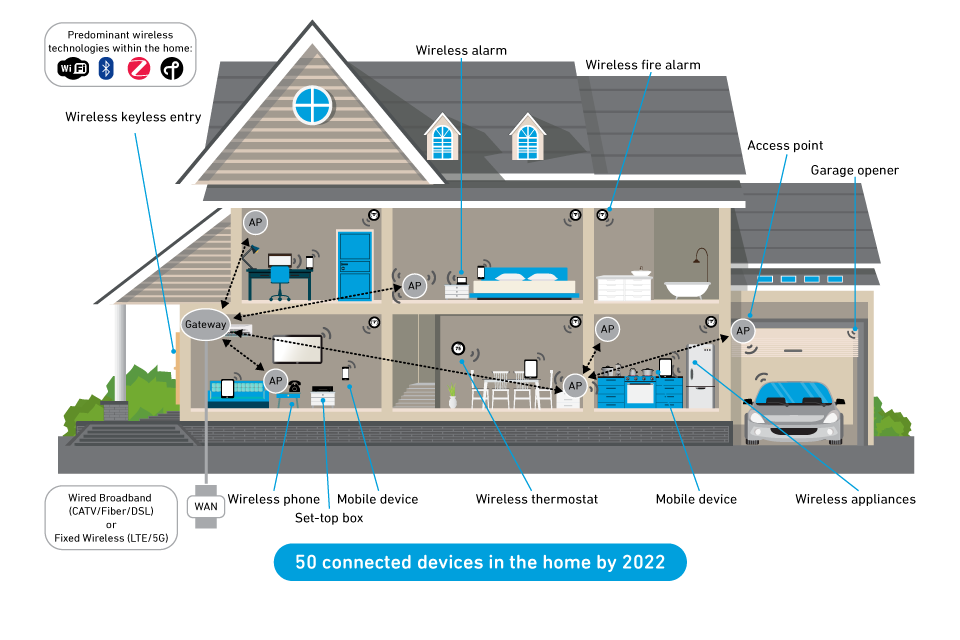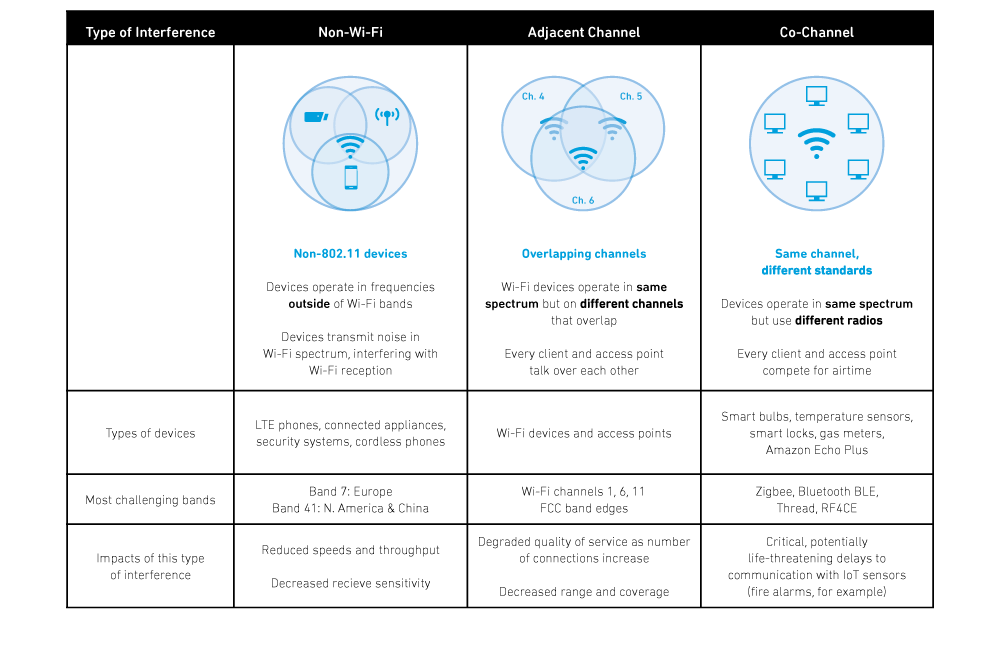How to make the optimum design choices to meet coexistence requirements while achieving performance targets.
The terms coexistence and interference describe the same connectivity issue from different perspectives. Interference is a key concern when designing Wi-Fi products, especially since homes today include a fast-growing number of different wireless devices complete with their different wireless communication protocols. Coexistence is the goal: allowing all the radios, protocols and standards to operate without causing problems within the same connected environment.
Let’s explore the wireless environment of today’s connected home – where many devices and standards can interfere with Wi-Fi – and then examine some strategies Wi-Fi designers can employ to address and solve the primary types of Wi-Fi interference.
The evolving wireless home environment
Wireless connectivity is the easiest, most reliable and most cost-effective way to create a connected home or office — or a smart city. The number of wireless devices in the home is expanding with extraordinary speed: by 2022, the average home is projected to have up to 50 connected devices, including cell phones, TVs, computers, appliances, and smart thermostats (Figure 1).
Many of these devices will communicate via Wi-Fi, while others will use cellular connections or local-area Internet of Things (IoT) networks such as Zigbee, Bluetooth Low Energy (BLE) and Thread. To provide the required connectivity, the smart home is moving to a distributed Wi-Fi model that includes access points throughout the home and support for more standards.
The proliferation of devices and different wireless standards creates a hotbed for potential coexistence and interference issues, and it means Wi-Fi designers potentially must address several types of interference.
Figure 1. Wireless Indoor Architecture with a Pod in Every Room

The three types of Wi-Fi interference and how to address them
Three primary types of interference can affect Wi-Fi systems: non-Wi-Fi, adjacent channel and co-channel (Figure 2).
Figure 2. The Three Models of Wi-Fi Interference

There are two primary ways to address coexistence and interference within Wi-Fi CPE units (Figure 3):
- Establish coordination between the radios. Preventing one radio (Wi-Fi, Bluetooth, Zigbee, etc.) from trying to talk at the same time as another can avoid potential co-channel interference. This can be achieved using a system-on-a-chip (SoC) solution that supports multiple standards and coordinates communication among them.
- Create sufficient levels of isolation between potential sources of interference. This can be accomplished using RF filters and by managing the board layout and antenna design. Filters are the most cost-effective and scalable approach. They help with adjacent channel and non-Wi-Fi interference.
Two primary filter technologies are used in RF applications: bulk acoustic wave (BAW) and surface acoustic wave (SAW). BAW filters offer the highest performance for many applications within the home and are particularly well suited to the higher frequencies used for Wi-Fi and other standards.
- BAW filters have lower insertion loss, higher power handling, steeper skirts and a higher Q factor than SAW filters and are also more temperature-stable. BAW filters therefore enable more effective use of the full Wi-Fi spectrum, increasing capacity and range.
- Due to their higher performance, BAW filters provide better future-proofing for the stringent performance requirements of 802.11ac and 802.11ax (Wi-Fi 6) standards.
Figure 3. Ways to Address the Three Types of Wi-Fi Interference

Considerations for addressing interference
In Wi-Fi systems, the specifications for addressing interference are much less well-defined than other parameters such as throughput and range. This means that designers need to look beyond the basic system specifications when selecting RF components, and carefully consider the potential coexistence issues and solutions. These include:
- How interference affects receive sensitivity and throughput
- How much isolation is needed
- Temperature stability
- Insertion losses of the system and overall link budget
- Coexistence with other standards using Wi-Fi spectrum (Zigbee, Thread, Bluetooth, etc.)
Sensitivity and its impacts on throughput
The goal of Wi-Fi 6 is to deliver very high data rates, potentially reaching gigabits per second. To achieve this performance, 802.11ax requires very high linearity (low EVM) throughout the transmit and receive RF chains. It requires greater receive sensitivity than earlier Wi-Fi standards, and therefore is more impacted by interference that reduces sensitivity. Coexistence filters are already widely used in smartphones and other client devices to provide isolation necessary to prevent non-Wi-Fi interference; with 802.11ax, there will be a greater imperative to use coexistence filters in Wi-Fi access points as well.
Isolation: How much is needed?
Most antenna designs can provide 20-30 dB of isolation between unintended (interferer) and intended signals (wireless). But to get good throughput, interferer signals should not exceed -70 to -90 dBc — which means that designers need to build another 40-60 dB of isolation into the Wi-Fi front-end system. Filters can help significantly.
For non-Wi-Fi interference, a BAW Wi-Fi coexistence filter provides isolation that protects receive sensitivity and prevents performance degradation. As shown in Figure 4, interference shifts the baseline packet error rate (PER) curve to the right; beyond a certain threshold, the receiver can no longer interpret the incoming data. A coexistence filter greatly improves sensitivity; the PER curve moves to the left.
Figure 4. How Interference Impacts Throughput on the Receive (Rx) Path

Temperature: What is the performance, stability or sensitivity of the device?
Not all filters are created equal. A filter’s frequency response drifts as the temperature changes. If an LTE or other non-Wi-Fi interferer is close enough in frequency that it overlaps the temperature drift of the device, the Wi-Fi system will have no protection.
Temperature-compensated filters, which have much less temperature drift, are designed to counteract this problem and are an important component of high-performance Wi-Fi systems. As shown in Figure 5, temperature-compensated BAW filters offer an improvement in temperature stability over SAW filters. They also offer much higher Q factors than SAW – which is an important factor since SAW may not even be an option for 802.11ax due to the stringent linearity, throughput and performance requirements.
Figure 5. SAW versus BAW Thermal Drift

Insertion losses of the system affect overall link budget and thermals inside the box
Lower insertion loss means a better link budget. BAW offers lower insertion loss than SAW at the higher frequency bandwidths used by Wi-Fi. This translates into higher output power and operating range, and better receive sensitivity. Decreasing the insertion loss by 0.5 dB translates to an 11% improvement in power-added efficiency, which also means an 11% improvement in thermal dissipation.
Temperature also has an impact on co-channel coexistence since it affects system margin. A system with more margin for temperature can allow for more capacity.
Coexistence with other standards (e.g., Zigbee, Thread, Bluetooth)
Coexistence between Wi-Fi and other standards can be achieved by coordination (time multiplexing) or filters (frequency multiplexing). Key transceiver solutions use time multiplexing to support Wi-Fi and IoT standards that share the same spectrum. However, performance and throughput start to degrade as the number of devices increases, duty cycles increase, or airtime becomes more congested. A complementary approach of frequency multiplexing, using filters, can expand network capacity and improve reliability.
The takeaway
In Wi-Fi product design, coexistence and interference are important issues affecting the user experience that often don’t get enough attention. Interference is becoming a bigger concern due to the growing number of devices and network standards within the home, and because the transition to Wi-Fi 6 (802.11ax) requires higher performance. Depending on the type of interference, approaches to solving the issues include BAW coexistence and bandedge filters, as well as transceivers that coordinate communication among multiple standards.

